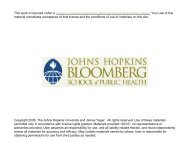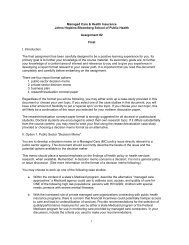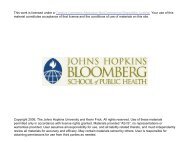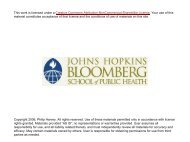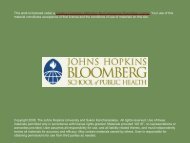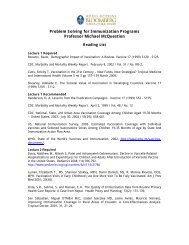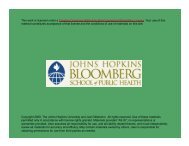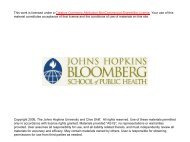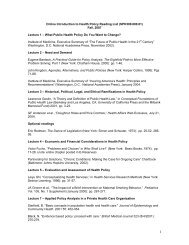Lecture 1 - jhsph ocw - Johns Hopkins Bloomberg School of Public ...
Lecture 1 - jhsph ocw - Johns Hopkins Bloomberg School of Public ...
Lecture 1 - jhsph ocw - Johns Hopkins Bloomberg School of Public ...
You also want an ePaper? Increase the reach of your titles
YUMPU automatically turns print PDFs into web optimized ePapers that Google loves.
This work is licensed under a Creative Commons Attribution-NonCommercial-ShareAlike License. Your use <strong>of</strong> this<br />
material constitutes acceptance <strong>of</strong> that license and the conditions <strong>of</strong> use <strong>of</strong> materials on this site.<br />
Copyright 2007, The <strong>Johns</strong> <strong>Hopkins</strong> University and Ronald Gray. All rights reserved. Use <strong>of</strong> these materials<br />
permitted only in accordance with license rights granted. Materials provided “AS IS”; no representations or<br />
warranties provided. User assumes all responsibility for use, and all liability related thereto, and must independently<br />
review all materials for accuracy and efficacy. May contain materials owned by others. User is responsible for<br />
obtaining permissions for use from third parties as needed.
Epidemiology <strong>of</strong> Reproductive Physiology<br />
• Review physiology <strong>of</strong> female<br />
reproduction<br />
• Menarche, menopause and the<br />
reproductive life span<br />
• Factors which affect menarche,<br />
menopause and reproductive life span<br />
• Menstrual cycle, conception and<br />
pregnancy loss
Female Reproductive Tract<br />
<strong>Public</strong> Domain
Physiology Hypothalamus<br />
• Hypothalamic Gonadotrophin Releasing<br />
Hormone (GnRH) stimulates release <strong>of</strong><br />
pituitary follicular stimulating hormone<br />
(FSH) and luteinizing hormone (LH)<br />
• Hypothalamic positive and negative<br />
feedback in menstrual cycle
Menstrual cycle ovarian physiology<br />
• FSH → follicular development during the follicular<br />
phase <strong>of</strong> the cycle → estrogen production →<br />
endometrial growth<br />
• LH & estrogen → ovulation → corpus luteum →<br />
estrogen + progesterone → endometrial maturation<br />
• No pregnancy: Degeneration <strong>of</strong> corpus luteum →<br />
decline in estrogen and progesterone → endometrial<br />
shedding and menses
GNU Free Documentation License<br />
Menstrual cycle
Fertilization<br />
• Ovulation releases ovum into the<br />
fallopian tube ~ day 14 after LMP<br />
• Fertilization ~ day 14-17<br />
• Tubal transport ~ day 14-19<br />
• Implantation ~ days 20-24
Implantation and pregnancy<br />
• Implantation → human chorionic<br />
gonadotrophin (hCG) maintains corpus<br />
luteum and estrogen and progesterone<br />
production<br />
• Estrogen promotes breast growth,<br />
• Prolactin (hPrL) → milk production.<br />
•<br />
• Estrogen suppresses hPrL and thus inhibits<br />
milk production during pregnancy
Natural Fertility<br />
The pattern <strong>of</strong> fertility observed in non-<br />
contracepting populations:<br />
• No attempt to control fertility or limit the<br />
number <strong>of</strong> children born<br />
• Spacing <strong>of</strong> births largely dependent on<br />
lactational amenorrhea
Total Births Per 1000 Women<br />
120<br />
100<br />
80<br />
60<br />
40<br />
20<br />
0<br />
44.4<br />
Natural Fertility<br />
105.5<br />
114.1<br />
92.5<br />
41.4<br />
15-19 20-24 25-29 30-34 35-39 40-44<br />
Age (years)<br />
Data Source: NCHS age-specific fertility 4-year average (2000-2003)<br />
8.3
Definition<br />
Menarche and Puberty<br />
Menarche (onset <strong>of</strong> first menses) is a late<br />
event in puberty (preceded by growth<br />
spurt, breast development, and pubic<br />
hair growth)
Biology <strong>of</strong> Menarche and Puberty<br />
Before puberty, ovarian estrogen and<br />
progesterone inhibit hypothalmic GnRH<br />
center (negative feedback).<br />
Early in puberty, GnRH released during sleep<br />
→ FH and FSH production with reduction <strong>of</strong><br />
negative feedback.<br />
Development <strong>of</strong> pulsatile GnRH release with<br />
positive steroid feedback initiates ovulation in<br />
girls and spermatogenesis in boys.
Number <strong>of</strong> oocytes decline with age,<br />
especially > 40<br />
Source: Lobo RA. Potential options for preservation <strong>of</strong> fertility in women. N Engl J Med.<br />
2005 Jul 7;353(1):64-73. Copyright © 2005 Massachusetts Medical Society. All Rights<br />
Reserved.<br />
Data are adapted from Faddy et al. (Hum Reprod 1992;7:1342-1346)
Mechanism <strong>of</strong> menarche and<br />
puberty<br />
• Mechanism unknown, but is linked to<br />
GPR54 gene on chromosome 19 which<br />
is needed for GnRH activity.<br />
• Mutations lead to sexual infantilism,<br />
pubertal delay which can be corrected<br />
by GnRH treatment
Female Hormones at Puberty<br />
ug%<br />
30<br />
25<br />
20<br />
15<br />
10<br />
5<br />
0<br />
FSH LH Estradiol<br />
7 8 9 10 11 12 13 14 15 16 17<br />
Age (years)
• ∼<br />
Mean Age <strong>of</strong> Menarche and<br />
12 - 13 years in developed countries<br />
• has declined by ∼<br />
1960’s.<br />
secular trends<br />
3 years per decade until<br />
• Probable improved health and nutrition
Factors associated with age <strong>of</strong><br />
menarche<br />
• Delayed menarche associated with<br />
physical, nutritional, or psychosocial<br />
stress<br />
– Studies in athletes, ballet dancers, poorly<br />
nourished populations
Stress and Menarche<br />
• Stress → cognitive response →<br />
hypothalmic corticol releasing hormone<br />
(CRH) →β-endorphin release → GnRH<br />
pulse inhibition → LH/FSH pulse<br />
suppression<br />
• Stress before menarche causes delays<br />
in onset (e.g., ballet dancers, athletes)
Fertility and Menarche<br />
• Fertility is low for 5-7 years following<br />
menarche<br />
• Adolescent subfertility is due to anovulation<br />
and luteal phase inadequacy<br />
• Menarche is not indicative <strong>of</strong> ovulation and<br />
the frequency <strong>of</strong> ovulatory cycles is lower for<br />
5-7 years after menarche
Diet and sex hormones in adolescence<br />
• Randomized trial <strong>of</strong> low fat diet in girls with<br />
lipid abnormalities<br />
• 5 year evaluation<br />
– Low fat reduced estrogens and<br />
progesterone and increased testosterone<br />
– Moderate changes in diet result in<br />
important changes in hypothalamic-ovarian<br />
axis<br />
Dorgan JNCI<br />
2003;95:132
Menopause<br />
Definition<br />
• Menopause: cessation <strong>of</strong> ovulation and<br />
menstruation lasting > 9-12 months<br />
• Perimenopausal period: Period <strong>of</strong><br />
increasing menstrual cycle length and<br />
variability preceding the menopause<br />
• Postmenopause: Amenorrhea > 12 months
Biology <strong>of</strong> Menopause<br />
Primary ovarian failure (programmed<br />
senesence or “apoptosis” <strong>of</strong> oocytes).<br />
Using hormonal stimulation and ovum<br />
donation from younger women,<br />
postmenopausal women can conceive<br />
and bear children.
Estrogen derived from adipose tissues in<br />
the postmenopausal state<br />
Estrone and estradiol are<br />
synthesized from androstenedione<br />
and testosterone in adipose tissues<br />
after the menopause<br />
Decreased serum hormone binding<br />
globulin (SHBG) increases bioavailability<br />
<strong>of</strong> steroids<br />
Thus, obesity is associated with<br />
higher estrogen levels in<br />
postmenopausal women
Age at Menopause<br />
• Median age ∼ 50 years. Little variation between<br />
populations (range <strong>of</strong> mean ages 48.8-51.5.<br />
Earliest mean age at menopause 44 years in<br />
malnourished populations),<br />
•<br />
• Early menopause associated with:<br />
– Smoking (↑ metabolism <strong>of</strong> estrogen)<br />
– Low body weight (lower estrogen production)<br />
– Poor nutrition / chronic infection (lower<br />
estrogen production
Age at menopause by birth cohort<br />
Nichols HB, et al. From Menarche to Menopause: Trends among US Women Born<br />
from 1912 to 1969. Am J Epidemiol 2006;1604:1003-1011. By permission <strong>of</strong> <strong>Johns</strong><br />
<strong>Hopkins</strong> <strong>Bloomberg</strong> <strong>School</strong> <strong>of</strong> <strong>Public</strong> Health. All Rights Reserved.
Age at Menopause<br />
• Late menopause associated with:<br />
– Obesity (possibly due to estradiol/estrone<br />
synthesis from androstedione/testosterone in<br />
adipose tissue)<br />
– Diabetes (same mechanism)<br />
– Endometrial and breast cancer (obesity and<br />
abnormal bleeding with endometrial cancer)
Risk Factors for Early Menopause<br />
< 50 yrs<br />
Risk Factor RR<br />
African-American 4.3<br />
Smoking 1.9<br />
Weight Loss 1.8<br />
Live Birth 0.7<br />
< High <strong>School</strong> Education 1.19
Non-Reproductive Effects <strong>of</strong> Estrogen<br />
• Bone growth and prevention <strong>of</strong> calcium re-<br />
sorption from cortical bone<br />
• Decreased hepatic lipase activity (increases<br />
high HDL-cholesterol, reduces LDL-<br />
cholesterol)<br />
• Maintain mucosa and connective tissue<br />
• Endogenous estrogens (estradiol, estriol, and<br />
estrone)
Postmenopausal Syndrome<br />
• Due to estrogen deficiency<br />
• Symptoms and health effects:<br />
– Vasomotor: Hot flashes and perspiration<br />
– Psychological: Mood lability, insomnia,<br />
depression<br />
– Musculoskeletal: Joint pains & stiffness<br />
– Mucosal atrophy (vaginal and bladder) and skin<br />
changes<br />
– Osteoporosis (calcium depletion due to<br />
estrogen deficiency)
Treatment <strong>of</strong> Postmenopausal Syndrome<br />
– Estrogen replacement reduces symptoms<br />
– Stopping estrogen may cause resurgence<br />
<strong>of</strong> symptoms (Ockene et al JAMA 2005;294:183)<br />
– Randomized trial <strong>of</strong> estrogen/progesterone<br />
vs placebo.<br />
– After stopping treatment<br />
• Flashes/sweats E/P 21%, placebo 4.8% (RR =<br />
5.8)
Study Group<br />
Efficacy <strong>of</strong> estrogen replacement<br />
(Data Source: Grady NEJM 2006;355:2338)<br />
Oral conjugated equine estrogens<br />
Percent Reduction in<br />
Frequency <strong>of</strong> Hot Flushes<br />
0.625 mg 94<br />
0.45 mg 78<br />
0.30 mg 78<br />
Placebo 44<br />
Oral 17β-estradiol<br />
2 mg 96<br />
1 mg 89<br />
0.5 mg 79<br />
0.25 mg 59<br />
Placebo 55<br />
Transdermal 17 β -estradiol<br />
0.1 mg 96<br />
0.05 mg 96<br />
0.025 mg 86<br />
Placebo 45<br />
Efficacy for prevention<br />
<strong>of</strong> hot flushes is greater<br />
with higher dose estrogen
Reproductive Life Span<br />
In developed countries<br />
– Median age at menarche ∼ 12-13 years<br />
– Median age at menopause ∼ 50 years<br />
– Length <strong>of</strong> reproductive life in females ∼<br />
38 years<br />
37-
Reproductive Life Span<br />
In less developed countries<br />
– Menarche <strong>of</strong>ten delayed (Latest menarche<br />
18 years)<br />
– Menopause generally ~ 50 years<br />
– Shortest reproductive life span ∼<br />
26 years
Mean reproductive life span by birth cohort<br />
Nichols HB, et al. From Menarche to Menopause: Trends among US<br />
Women Born from 1912 to 1969. Am J Epidemiol 2006;1604:1003-1011.<br />
By permission <strong>of</strong> <strong>Johns</strong> <strong>Hopkins</strong> <strong>Bloomberg</strong> <strong>School</strong> <strong>of</strong> <strong>Public</strong> Health. All<br />
Rights Reserved.
Epidemiology <strong>of</strong> the menstrual cycle<br />
• Epidemiology <strong>of</strong> the menstrual cycle<br />
parameters (follicular and luteal phases,<br />
ovulation and menses)<br />
• Epidemiology and endocrinology <strong>of</strong><br />
menstrual cycle disorders and toxic shock<br />
syndrome (TSS)
Menstrual Cycle Length<br />
• Mean cycle length: ∼29 days,<br />
• mode 28 days, 5th - 95th centiles 23-29<br />
days<br />
– Variability increased in young and older<br />
women (< 20 and > 35 years)<br />
– Variability maximum 2-5 years after<br />
menarche and before menopause
Menstrual Cycle<br />
• Mean Follicular Phase<br />
– 15 days (90th centiles 10.5 - 19 days)<br />
• Mean Luteal Phase<br />
– 13.5 days (90th centiles 8.7 - 17.2 days)<br />
– Short luteal phase < 9 days.
Stress and the Menstrual Cycle<br />
• Cycle variability increased with<br />
emotional, nutritional, and physical<br />
stress<br />
• Common CNS pathway (corticol<br />
releasing hormone (CRH) →β- endorphin release → GnRH pulse<br />
inhibition → LH/FSH pulse suppression
RRs <strong>of</strong> Prolonged Cycles (> 43 days)<br />
Risk Factor Relative Risk<br />
(95% CI)<br />
History <strong>of</strong> long 3.4 (1.6-7.1)<br />
cycles<br />
Start college 2.3<br />
Stress > median 3.1 (1.3-7.4)<br />
Activity > median 1.5 (1.0-2.3)<br />
Harlow and Matanoski. Am J Epidemiol 1991;133:38.
• Definition:<br />
Dysmenorrhea<br />
Pain, cramping associated with<br />
menstruation (back ache, nausea)<br />
• Biology: Due to prostaglandin<br />
production at menses
Dysmenorrhea<br />
• Frequency:<br />
– 30-60% <strong>of</strong> women report symptoms<br />
– 7-15% interfere with daily activities<br />
– More frequent among < 25 years (67-72%)<br />
• Decreases after pregnancy and with use <strong>of</strong><br />
oral contraceptives<br />
• Treatment: anti-prostaglandins oral<br />
contraception
Premenstrual Syndrome (PMS)<br />
• Definition<br />
– Recurring psychological and/or somatic symptoms<br />
during the luteal phase <strong>of</strong> the cycle, relieved by<br />
onset <strong>of</strong> menstruation<br />
• Frequency<br />
– 95% <strong>of</strong> women report mild symptoms<br />
– 5% severe symptoms disrupting normal life<br />
• Etiology<br />
– Unclear, appears to be an abnormal response to<br />
hormones, rather than disturbed hormonal milieu.<br />
– Abnormal serotonin levels? Treated with selective<br />
serotonin-reuptake inhibitors (SSRIs)
Randomized trials <strong>of</strong> PMS treatment<br />
• All trials show marked placebo effects<br />
• 15 Cross-over trials <strong>of</strong> selective seretonin re-<br />
uptake inhibitors (SSRIs, i.e.,<br />
antidepresentents) show benefit in<br />
psychological and physical symptoms<br />
• OR <strong>of</strong> improvement ~ 6.9<br />
– Dimmock Lancet 2000;356:1131
Toxic Shock Syndrome<br />
• Definition:<br />
Shock, rash, peeling skin, multiple organ<br />
failure, potentially fatal<br />
• Biology: Staphylococcus infection <strong>of</strong><br />
menstrual blood releases toxin causing<br />
extreme shock<br />
• Recognized in 1970’s; epidemic in 1980’s<br />
associated with tampon use (partly<br />
surveillance and detection bias)
Toxic Shock Syndrome<br />
• Risk increased with retention <strong>of</strong><br />
menstrual products (e.g., use <strong>of</strong> highly<br />
absorbent tampons, diaphragm)<br />
• Risk decreased with reduced menstrual<br />
loss (e.g., oral contraceptive use)<br />
• Treatment: antibiotics



